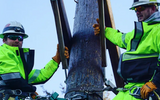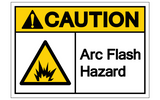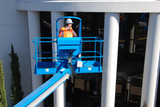Blog
When to Wash, Repair, or Replace Your Arc Flash & FR PPE
If you’re working in an industry where flame resistant (FR) workwear is standard attire, you should know how important it is. FR clothing reacts differently to fire and heat than the clothing you would wear on the street—it’s thermally insulated and designed to resist igniting, melting, tearing, or breaking. If it ignites it will extinguish much faster than other clothing. However, improper care or laundering can affect those properties and make you less safe at work.
The garment manuf
…
Jan 9th 2023
How to Read an Arc Flash Label
An arc flash warning label is commonly used to alert workers of a potential flash fire. It comes with important safety information about the type of threat or hazard in question, so workers can either avoid this area or make sure they are wearing the proper arc flash clothing before accessing equipment or stepping inside.“Warning” or “Danger”The label will feature a “warning” or “danger” heading. “Danger” usually appears in red. It means that the nominal system voltage is over 600 or that the in
…
Dec 18th 2020
How to Protect Against Arc Flash Hazards
An arc flash is a dangerous release of energy produced by an electrical fault in the air from one phase to another phase, or from one phase to the ground. The elements released during an arc flash event are: intense light, sound, pressure, and extremely high temperatures. Arc flash hazards exist in many professional environments, but those who work in or around energized electrical equipment are at the highest risk: maintenance workers, electricians, and operators engaged in working with elec
…
Nov 7th 2017
Arc Flash 101
Arc flash concerns were first published in 1982 in Ralph Lee's paper “The Other Electrical Hazard: Electric Arc Blast Burns.” Arc flash hazards were not formally studied until 1993, which is why they are still the least understood electrical hazard existing in most industries. Wikipedia defines arc flash as
"the light and heat produced from an electric arc supplied with sufficient electrical energy to cause substantial damage, harm, fire, or injury." Because arc flash temperature can reach
…
Sep 7th 2016
ARC Flash and OSHA Regulations in 2015
An arc flash occurs when an electrical current leaves its intended path and travels from one conductor to another. This may result in fire, flying objects (traveling at more than 700 mph), blast pressure, sound blast (exceeding 160 dB) and heat (exceeding 30,000 F). If an arc flash makes contact with a person, injury and death may occur depending on proximity of the worker to the source, temperature, and time for the circuit breaker to be disengaged. OSHA last issued an arc flash related rule
…
Jul 28th 2015
Comfortable Flame Resistant Work Clothing
For electricians and electric power industry workers the threat of electrical arc is the most serious they face. During their short blasts, flash hazard temperatures can be literally hotter than the sun. Combine this with the pressure wave from the explosion and searing flying metallic particles, and you've got yourself a seriously bad situation. The
clothing electrical workers choose can play an important role in how serious an injury is received in the event of one of these arc blasts.
…
Apr 20th 2015
Fall Protection for Welders and Highway Safety
Working at height can be dangerous. Welding is also rife with hazardous possibilities. Do them both at the same time and you're a special type of person. This photo was taken during a highway traffic stop in Costa Rica. While I don't consider the typical Costa Rican construction project to be overly safe, I was amazed to see the level of safety exhibited in this photo.
First let's look at the highway workers. They're all wearing
reflective safety vests. They are also wearing hard hat
…
Mar 18th 2015
Electrical Worker Fall Safety Regulation Changes in 2014
This past spring OSHA updated their safety regulations for electrical power generation, transmission, and distribution. The compliance deadline for most of these new rules as they relate to fall protection is April 1st, 2015. If your workers operate or maintain electrical service and are working at height, they are likely affected by these updates.
There are two main fall protection rules that are either new or changed. Foremost is the arc flash requirement. Fall arrest equipment has an
…
Dec 29th 2014
National Safety Apparel NSA Offers Smart Flame-Resistant Clothing
National Safety Apparel (NSA) has been making protective clothing for more than 75 years. They started in Cleveland at a time when steel and particularly wire production was in full swing. NSA was, and is, a family business dedicated to produced high-heat clothing, and as the requirements of industry have changed so have their products. Today NSA serves workers in electrical, oil & gas, thermal, cut-protective, flame-resistant, FR rainwear, and hi-visibility markets by producing some of the m
…
Mar 12th 2014
Arc Flash Protection Sees Improvements, Needs Clarification
Electricians have one of the most dangerous jobs in the country according to OSHA reports. While the wattage in homes is enough to cause serious damage or death, even greater danger occurs when workers are exposed to the major electrical forces involved with municipalities and major factory and industrial work. And while training and experience are often the best ways to avoid injury, there are tools and clothing that are specially made to help an electrician fare better in the event of an ac
…
Jan 30th 2013











